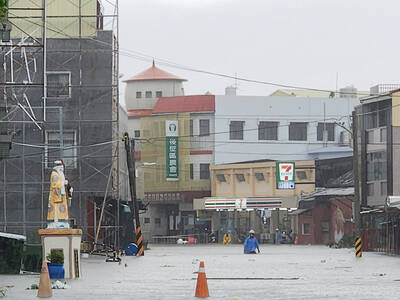World oil prices rose by more than US$1 in Asian trading yesterday after Hurricane Gustav forced the shutdown of almost all oil production in the Gulf of Mexico.
New York’s main contract, light sweet crude for delivery in October, rose US$1.17 to US$116.63 a barrel from its close of US$115.46 on Friday at the New York Mercantile Exchange. Brent North Sea crude for October gained US$1.04 to US$115.09 from US$114.05 in London on Friday.
About one-quarter of US oil production comes from the Gulf, but US officials said on Sunday that more than 96 percent of Gulf oil production and 82 percent of natural gas output had been stopped in the face of the storm.
“It’s all about Gustav,” said Tony Nunan of Mitsubishi Corp’s international petroleum business in Tokyo.
Heavy winds and rains began battering the Gulf Coast yesterday, although the eye of the storm was not expected to make official landfall until later in the day.
Nunan said price gains had been limited because of underlying worries about a global economic slowdown and falling demand for oil.
World oil prices have sunk from record highs above US$147 a barrel in early July after surging from US$100 at the start of the year.
Monday’s rise of about US$1 was “not really that much,” Nunan said, adding that trading would be thin because the US markets were shut for the Labor Day holiday yesterday.
If oil facilities survive the storm undamaged, the oil price could continue its trend down. But damage on the scale of Hurricane Katrina three years ago could generate a price surge to US$120, Nunan said.
The threat of Gustav raised grim memories of the 2005 hurricanes Katrina and Rita that damaged or destroyed about 165 of around 4,000 oil platforms in the Gulf.
US energy giant ExxonMobil said on Sunday it had completed storm preparations for its Gulf Coast oil and gas operations. Workers on offshore platforms had been evacuated, the company said.
“We are also releasing personnel from onshore facilities anticipated to be in or near the path of the storm,” it said in a statement, adding the company expected to continue supplying its customers.
One of ExxonMobil’s refineries, in Chalmette, Louisiana, was being shut down, but Exxon’s other refineries and chemical plants on the Gulf Coast remained in operation as of Sunday, the company said.
Shell, in addition to its offshore facilities, was also shutting a number of its coastal refineries and chemical plants while putting others on standby.
British oil group BP and US rival ConocoPhillips also evacuated offshore workers.
Oil industry analyst Andy Lipow, based in Houston, Texas, said there would be a supply disruption, “but how quickly can the industry recover is going to be the key.”
Lipow said the oil industry was now better prepared for storms, both with offshore and onshore facilities.

Rainfall is expected to become more widespread and persistent across central and southern Taiwan over the next few days, with the effects of the weather patterns becoming most prominent between last night and tomorrow, the Central Weather Administration (CWA) said yesterday. Independent meteorologist Daniel Wu (吳德榮) said that based on the latest forecast models of the combination of a low-pressure system and southwesterly winds, rainfall and flooding are expected to continue in central and southern Taiwan from today to Sunday. The CWA also warned of flash floods, thunder and lightning, and strong gusts in these areas, as well as landslides and fallen

WAITING GAME: The US has so far only offered a ‘best rate tariff,’ which officials assume is about 15 percent, the same as Japan, a person familiar with the matter said Taiwan and the US have completed “technical consultations” regarding tariffs and a finalized rate is expected to be released soon, Executive Yuan spokeswoman Michelle Lee (李慧芝) told a news conference yesterday, as a 90-day pause on US President Donald Trump’s “reciprocal” tariffs is set to expire today. The two countries have reached a “certain degree of consensus” on issues such as tariffs, nontariff trade barriers, trade facilitation, supply chain resilience and economic security, Lee said. They also discussed opportunities for cooperation, investment and procurement, she said. A joint statement is still being negotiated and would be released once the US government has made

SOUTH CHINA SEA? The Philippine president spoke of adding more classrooms and power plants, while skipping tensions with China over disputed areas Philippine President Ferdinand Marcos Jr yesterday blasted “useless and crumbling” flood control projects in a state of the nation address that focused on domestic issues after a months-long feud with his vice president. Addressing a joint session of congress after days of rain that left at least 31 dead, Marcos repeated his recent warning that the nation faced a climate change-driven “new normal,” while pledging to investigate publicly funded projects that had failed. “Let’s not pretend, the people know that these projects can breed corruption. Kickbacks ... for the boys,” he said, citing houses that were “swept away” by the floods. “Someone has

‘CRUDE’: The potential countermeasure is in response to South Africa renaming Taiwan’s representative offices and the insistence that it move out of Pretoria Taiwan is considering banning exports of semiconductors to South Africa after the latter unilaterally downgraded and changed the names of Taiwan’s two representative offices, the Ministry of Foreign Affairs (MOFA) said yesterday. On Monday last week, the South African Department of International Relations and Cooperation unilaterally released a statement saying that, as of April 1, the Taipei Liaison Offices in Pretoria and Cape Town had been renamed the “Taipei Commercial Office in Johannesburg” and the “Taipei Commercial Office in Cape Town.” Citing UN General Assembly Resolution 2758, it said that South Africa “recognizes the People’s Republic of China (PRC) as the sole